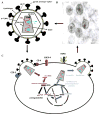Taking a hard look at the pathogenesis of childhood HIV-associated nephropathy
- PMID: 19288142
- PMCID: PMC2778297
- DOI: 10.1007/s00467-009-1155-4
Taking a hard look at the pathogenesis of childhood HIV-associated nephropathy
Abstract
Childhood human immunodeficiency virus-associated nephropathy (HIVAN) is defined by the presence of proteinuria associated with mesangial hyperplasia and/or global-focal segmental glomerulosclerosis, in combination with the microcystic transformation of renal tubules. This review discusses the pathogenesis of childhood HIVAN and explores how the current pathological paradigm for HIVAN in adults can be applied to children. The Human Immunodeficiency Virus-1 (HIV-1) induces renal epithelial injury in African American children with a genetic susceptibility to develop HIVAN. The mechanism is not well understood, since renal epithelial cells harvested from children with HIVAN do not appear to be productively infected. Children with HIVAN show a renal up-regulation of heparan sulphate proteoglycans and a recruitment of circulating heparin-binding growth factors, chemokines, and mononuclear cells. Macrophages appear to establish a renal HIV-reservoir and transfer viral particles to renal epithelial cells. All of these changes seem to trigger an aberrant and persistent renal epithelial proliferative response. The paradigm that viral products produced by infected renal epithelial cells per se induce the proliferation of these cells is not supported by data available in children with HIVAN. More research is needed to elucidate how HIV-1 induces renal epithelial injury and proliferation in HIV-infected children.
Figures





Similar articles
-
A 20-year history of childhood HIV-associated nephropathy.Pediatr Nephrol. 2004 Oct;19(10):1075-92. doi: 10.1007/s00467-004-1558-1. Epub 2004 Aug 5. Pediatr Nephrol. 2004. PMID: 15300477 Review.
-
HIV-associated nephropathy: experimental models.Contrib Nephrol. 2011;169:270-285. doi: 10.1159/000320212. Epub 2011 Jan 20. Contrib Nephrol. 2011. PMID: 21252526
-
Fibroblast growth factor-2 increases the renal recruitment and attachment of HIV-infected mononuclear cells to renal tubular epithelial cells.Pediatr Nephrol. 2005 Dec;20(12):1708-16. doi: 10.1007/s00467-005-2018-2. Epub 2005 Aug 16. Pediatr Nephrol. 2005. PMID: 16133048
-
Infection of human primary renal epithelial cells with HIV-1 from children with HIV-associated nephropathy.Kidney Int. 1998 May;53(5):1217-29. doi: 10.1046/j.1523-1755.1998.00900.x. Kidney Int. 1998. PMID: 9573536
-
HIV-1 and kidney cells: better understanding of viral interaction.Nephron Exp Nephrol. 2010;115(2):e15-21. doi: 10.1159/000312882. Epub 2010 Apr 21. Nephron Exp Nephrol. 2010. PMID: 20407278 Free PMC article. Review.
Cited by
-
Infection-Related Focal Segmental Glomerulosclerosis in Children.Biomed Res Int. 2016;2016:7351964. doi: 10.1155/2016/7351964. Epub 2016 May 17. Biomed Res Int. 2016. PMID: 27294131 Free PMC article. Review.
-
HIV-associated nephropathy in the setting of maximal virologic suppression.Pediatr Nephrol. 2011 Jun;26(6):973-7. doi: 10.1007/s00467-011-1783-3. Epub 2011 Feb 25. Pediatr Nephrol. 2011. PMID: 21350798
-
Kidney disease in children and adolescents with perinatal HIV-1 infection.J Int AIDS Soc. 2013 Jun 18;16(1):18596. doi: 10.7448/IAS.16.1.18596. J Int AIDS Soc. 2013. PMID: 23782479 Free PMC article. Review.
-
Clinical practice guideline for the management of chronic kidney disease in patients infected with HIV: 2014 update by the HIV Medicine Association of the Infectious Diseases Society of America.Clin Infect Dis. 2014 Nov 1;59(9):e96-138. doi: 10.1093/cid/ciu617. Epub 2014 Sep 17. Clin Infect Dis. 2014. PMID: 25234519 Free PMC article.
-
The physical and psychological effects of HIV infection and its treatment on perinatally HIV-infected children.J Int AIDS Soc. 2015 Dec 2;18(Suppl 6):20258. doi: 10.7448/IAS.18.7.20258. eCollection 2015. J Int AIDS Soc. 2015. PMID: 26639114 Free PMC article.
References
-
- UNAIDS. Joint United Nations Programme on HIV/AIDS. UNAIDS; Geneva: 2007. AIDS Epidemic update. Available at www.unaids.org/en/KnoweldgeCenter/HIVData/EpiUpdate/EpicUpdArchive/2007. - PubMed
-
- Strauss J, Abitbol CL, Zilleruelo G, Scott G, Paredes A, Malaga S, Montane B, Mitchell C, Parks W, Pardo V. Renal diseases in children with the acquired immunodeficiency syndrome. N Engl J Med. 1989;321:625–630. - PubMed
-
- Connor E, Gupta S, Joshi V, DiCarlo F, Offenberger J, Minnefor A, Uy C, Oleske J, Ende N. Acquired immunodeficiency syndrome renal diseases in children. J Pediatr. 1988;113:39–44. - PubMed
-
- Ray PE, Rakusan TM, Loechelt BJ, Selby DM, Liu X-H, Chandra RS. Human immunodeficiency virus (HIV)-associated nephropathy in the children from the Washington D.C. area: 12 years’ experience. Semin Nephrol. 1998;18:396–405. - PubMed
Publication types
MeSH terms
Grants and funding
LinkOut - more resources
Full Text Sources

